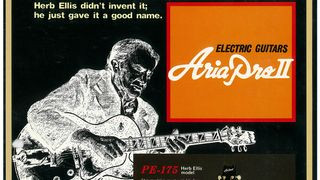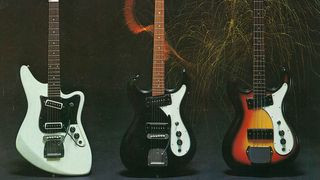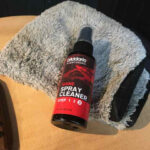While the names Gibson and Fender often dominate conversations about iconic guitar manufacturers, the Aria Guitar Company has quietly carved out its own impressive legacy. For over 60 years, Aria, though sometimes considered an outsider, has consistently delivered instruments of remarkable craftsmanship and innovation, earning a respected place in guitar history.
From legendary players like Herb Ellis and Andy Summers to modern virtuosos such as Yngwie Malmsteen and George Lynch, many renowned guitarists have, at some point, embraced Aria guitars, particularly models from the acclaimed Aria Pro II series. Even in today’s fiercely competitive market, Aria continues to thrive, driven by the same inventive spirit that marked its beginnings.
The story of the Aria Guitar Company is rooted in necessity. In 1956, in Nagoya, Japan, Shiro Arai, a talented classical guitarist, faced a common frustration: the scarcity of quality nylon strings in his home country for his classical guitar.
Driven by this need, Arai took initiative and began importing classical guitar strings from Augustine, a reputable manufacturer based in New York City. Word quickly spread among Japanese guitarists, and as demand for Augustine strings surged, Arai established Arai & Co. Inc. to manage the burgeoning business. With the rise of rock and roll in the late 1950s and early 1960s, Arai expanded his imports to include guitars, initially featuring Framus models from Germany.
 Aria Guitars
Aria Guitars
(Image credit: Aria Guitars showcasing their brand logo)
Expanding into Guitar Manufacturing: The Birth of Aria and Aria Diamond
The early 1960s marked a pivotal shift for Arai & Co. as they ventured into guitar production. In 1960, the company began manufacturing its own line of acoustic and hollowbody guitars. This was followed in 1963 by the introduction of solidbody electric guitars. To differentiate the lines, the company used the brand name Aria (an anagram of Arai) for the solidbody electrics and Aria Diamond for their hollowbody guitars and basses. It wasn’t long before Aria guitars began reaching international markets, including the United States, establishing their presence on a global scale.
As demand for Aria instruments grew steadily, Arai sought a reliable manufacturing partner. They entered into a crucial partnership with Matsumoku Industrial, a woodworking company located in Matsumoto, Nagano. Matsumoku had a history of crafting high-quality wooden products, initially building cabinets for Singer sewing machines and later expanding into television and home audio cabinets. However, when Singer relocated its cabinet production to the Philippines in the early 1960s, Matsumoku strategically shifted its focus to musical instrument manufacturing, proving to be an ideal partner for the burgeoning Aria Guitar Company.
The global phenomenon of Beatlemania in the mid-1960s significantly influenced guitar design trends. Recognizing this, Aria responded by producing violin-shaped guitars, directly inspired by Paul McCartney’s iconic Höfner 500/1 bass, catering to the popular demand for instruments associated with the British Invasion sound.
Innovative Designs and Rising Popularity: The 1532T and Beyond
1968 witnessed the arrival of Aria’s popular 1532T solidbody guitar, a model that demonstrated Aria’s willingness to embrace bold and contemporary designs. Featuring a striking, angular offset body, clearly influenced by the Fender Jaguar and Jazzmaster, the 1532T resonated with guitarists seeking instruments with a modern aesthetic and versatile sound.
The success of the 1532T paved the way for a wave of new Aria models. These included the 1702T, a faithful rendition of the Mosrite Ventures guitar (remarkably similar to the Univox Hi-Flyer model built by Matsumoku and famously used by Kurt Cobain). Other notable releases were the R-320, a close copy of the Rickenbacker 360, and the Aria Diamond 1412, a violin-shaped 12-string hollowbody electric guitar, further expanding Aria’s diverse catalog and solidifying their reputation for producing quality instruments across various styles.
 Aria Guitars
Aria Guitars
(Image credit: A collection of vintage Aria guitars showcasing different body styles)
During the late 1960s, Aria, in collaboration with Matsumoku, began producing Les Paul copies. This move was significant as it inspired other Japanese guitar manufacturers, including Fujigen Gakki (known for Greco and Ibanez guitars) and Tokai, to follow suit. This period marked the beginning of Japanese guitar makers gaining prominence for producing high-quality, more affordable alternatives to classic American designs.
Eventually, the proliferation of Japanese-made copies led to legal pressures. When Norlin/Gibson threatened Hoshino (Ibanez) with a lawsuit for trademark infringement, Aria and other Japanese manufacturers responded strategically. They cautiously shifted their focus towards developing original designs for the export market while continuing to produce copies primarily for domestic sales. This strategic pivot highlighted the adaptability and innovative spirit within the Aria Guitar Company and the broader Japanese guitar industry.
The Aria Pro II Era: High-End Innovation and Endorsements
Aria entered its most prolific decade in 1976 with the unveiling of the Aria Pro II prototype series. The very first Aria Pro II model, the PE-1500, launched the following year. This guitar was a testament to Aria’s commitment to crafting high-end instruments for professional musicians. The PE-1500 featured a modified Les Paul-inspired single cutaway body constructed with maple, mahogany, and maple layers. It boasted a hand-carved arched top and back, an innovative heel-less cutaway for enhanced upper fret access, and two powerful black-bobbin DiMarzio Super Distortion humbucker pickups. Finished in an elegant Antique Violin finish, the PE-1500 was a clear statement of Aria’s ambition to compete in the high-end electric guitar market.
Nobuaki Hayashi, a talented young chief designer at Matsumoku, operating under the pseudonym H. Noble, played a crucial role in shaping many Aria Pro II designs, including much of the PE-1500. His signature, “Designed & Approved by H. Noble,” was often stamped on the headstocks of these guitars. Over time, these H. Noble-designed models have become increasingly sought after by guitar collectors, recognizing Hayashi’s significant contribution to Aria’s success. Hayashi later departed the company in the late 1980s to establish Atlansia Guitars, a boutique guitar and bass company in Japan.
The PE-1500’s warm reception led to the development of further models in the PE series. The PE-800 arrived in 1978, followed by the PE-600, PE-500, and PE-400 in subsequent years. Each new model incorporated refinements and improvements, whether in the materials used, enhanced functionality, or decorative elements like binding, demonstrating Aria’s continuous pursuit of excellence.
Aria Pro II PE guitars quickly gained favor among prominent guitarists. Neal Schon of Journey, Andy Summers of The Police (famously seen playing one during The Police’s 1978 performances on The Old Grey Whistle Test), and Gerry Cott of The Boomtown Rats all embraced Aria Pro II PE models, further solidifying the brand’s credibility and appeal.
Henrik Flyman, guitarist for the Scandinavian metal band Evil Masquerade, is a dedicated Aria Pro II PE player who has championed the model in the modern era. He recounts discovering his PE-1500 in a local music shop, noting its superior playability compared to a Gibson Les Paul, particularly praising the deep cutaway and heel-less neck joint for effortless access to higher frets.
Shortly after the Aria Pro II guitar line debuted, the Aria Pro II SB (Super Bass) series emerged in the late 1970s. The flagship SB-1000 bass rapidly became a favorite among influential bassists like Cliff Burton of Metallica, John Taylor of Duran Duran, and Cronos of Venom. Throughout the 1980s, prominent musicians such as Michael Anthony of Van Halen, Jack Bruce, and Rudy Sarzo of Whitesnake were frequently seen performing with Aria SB basses. Even today, Metallica bassist Robert Trujillo often plays an Aria SB when performing songs from the band’s Cliff Burton era, highlighting the enduring legacy of this instrument.
American jazz guitar legend Herb Ellis became Aria’s first high-profile endorser in 1978. The PE-175 Herb Ellis model, an archtop electric guitar heavily inspired by the Gibson ES-175, remained in production until the late 1980s, testament to its popularity among jazz guitarists.
Between 1978 and 1982, Aria produced the Aria Pro II Rev-Sound series (RS-850, RS-750, RS-600, and others). These models featured neck-thru-body construction, laminated multi-layer maple and walnut necks, and active electronics on select models (RS-850 and RS-1000Z). The Rev-Sound guitars bore a resemblance to Alembic and Ibanez Musician “hippie sandwich” models popular in the late 1970s, showcasing Aria’s awareness of contemporary design trends.
The Aria Pro II catalog expanded further in the early 1980s with the introduction of the Cardinal series (CS) and Thor Sound/Tri-Sound (TS) models. These series offered a range of construction styles, including bolt-on, set-neck, and neck-thru-body designs, catering to diverse player preferences. As heavy metal music surged in popularity, demand for Super Strat guitars increased. Aria responded by launching the Aria Pro II RS Esprit in 1983, a more streamlined evolution of the RS-850. Notably, Yngwie Malmsteen briefly favored the RS Esprit during his time with Alcatrazz from 1983 to 1984.
George Lynch also briefly played the Aria Pro II RS Knight Warrior in 1984 and was photographed with the guitar for the back cover of Dokken’s Tooth and Nail album. Lynch recalls being excited about his first endorsement deal with Aria and using an Aria acoustic guitar extensively on Tooth and Nail, including the acoustic work on their hit song “Alone Again.”
Aria’s commitment to heavy metal-inspired designs continued with the introduction of Flying V-style Aria Pro II XX models (including the rare XX-MS Michael Schenker signature model, Schenker’s first signature V guitar), Explorer-style Aria Pro II ZZ models, and Aria Pro II Urchin series guitars, which resembled the B.C. Rich Stealth, reflecting the evolving tastes of the guitar-playing community.
Navigating Change and Revival: From Matsumoku to Today
When Matsumoku closed its factory in 1987, it marked a significant shift for Aria. The company moved its primary guitar manufacturing operations to Korea and outsourced production of certain models to other factories in Japan. Throughout the 1990s, new models were added to the PE series, such as the PE-SP and PE-DLX. However, the Aria Pro II line experienced a decline in popularity and sales during this decade, as musical tastes and market trends shifted.
Despite these changes, Aria maintained its reputation for innovation with the introduction of the SWB series upright electric bass guitars. These slim, compact, modern basses, featuring a Fishman custom bridge piezo pickup and active tone circuitry, helped Aria remain respected as an innovator in bass guitar design. The company continues to offer SWB basses today, demonstrating their ongoing relevance.
From 1995 to 1999, Aria produced the Strat-style Aria Pro II FL (Fullerton Series) line. These guitars were manufactured in Korea, with the exception of the high-end USA-made FL-50S and FL-60H models. Many Fullerton Series guitars featured Wilkinson vibratos, Seymour Duncan pickups, and Sperzel tuners, indicating a focus on quality components.
The enduring popularity of the American instrumental guitar group The Ventures in Japan since their first tour in 1964 led to a unique collaboration. In 1991, Aria partnered with The Ventures to offer the first Ventures signature model instruments, initially exclusively for the Japanese market. Aria released an upgraded version in 1999, and in 2001, 2002, and 2003, they introduced Ventures signature models for markets outside Japan, including the U.S. These Ventures models were heavily inspired by the Mosrite Ventures guitars that the band had endorsed from 1963 to 1968, appealing to fans of surf rock and instrumental guitar music.
As Aria transitioned into the 21st century, the Aria Pro II brand name was simplified to just Aria for overseas markets in 2000, while Pro II remained exclusive to Japan. However, renewed interest in the classic Aria Pro II models of the past led the company to revive the Aria Pro II name across all markets by 2013, acknowledging the enduring appeal of their iconic series.
 Aria Guitars
Aria Guitars
(Image credit: Aria Guitars showcasing modern and retro models)
In 2011, Aria launched the Retro Style Series, which included the Retro 1532, a faithful recreation of the original 1532T from 1968, appealing to vintage guitar enthusiasts. In 2020, Aria introduced the completely new JET series of guitars, baritone guitars, and basses, featuring a distinctive offset single cutaway body design, demonstrating their continued commitment to innovation. Responding to popular demand, Aria added the Hi-Flyer-style DM-206 guitar and DMB-206 bass to its Retro series in 2021, further expanding their retro-inspired offerings.
Recently, Aria unveiled the Hot Rod Collection, drawing inspiration from the American-made Aria Fullerton guitars of the 1990s. These guitars emphasize their U.S. connection through model names referencing American cities or neighborhoods and their area codes, such as the “714 Fullerton,” “615 Nashville,” and “212 Bowery.” The Japan-made Platinum Collection represents a revival of classic models, including the SB-1000 bass and several PE guitars like the beloved PE-1500, alongside the TA-Tonic thinline semi-hollow electric, showcasing Aria’s dedication to both heritage and contemporary craftsmanship.
As the Aria Guitar Company enters its seventh decade, their passion for and dedication to guitar making remains as strong as ever. Kazuyuki Miyamoto from Aria Guitars’ International Sales Division in Japan emphasizes their enduring mission: “We want to keep encouraging people to play and create music by providing attractive instruments at a reasonable price.” This commitment to accessibility and quality ensures that the Aria Guitar Company will continue to inspire musicians for generations to come.

